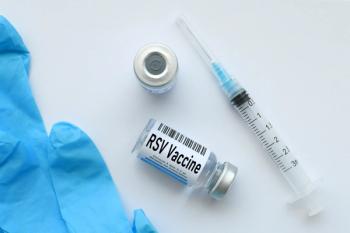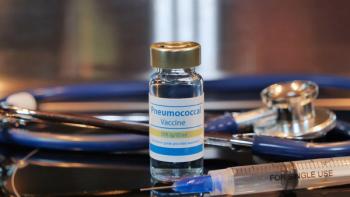Multiple myeloma (MM) is a hematologic malignancy involving an abnormal clonal proliferation of plasma cells in the bone marrow, along with their excess production of monoclonal immunoglobulin (M protein).1 Malignant plasma cells on biopsy and M protein in serum and urine are required for diagnosis, with a decrease from baseline indicating a positive response to treatment.1 Myeloma-defining features include hypercalcemia, renal insufficiency, anemia, and bone lesions.1 MM is considered incurable yet treatable, and it grows slowly in its earlier Revised International Staging System (R-ISS) stages. At diagnosis of R-ISS stage I, the median 5-year survival rate is 77% and declines to 47% in R-ISS stage III.1
The substantial improvement in survival rates since the approval of the first proteasome inhibitor and immunomodulatory agent in the 2000s is due to advancements in the treatment landscape, notably combination regimens and newer generations of treatment options. At diagnosis, assessing a patient’s candidacy for autologous hematopoietic stem cell transplantation is standard of care, as it influences the choice of initial combination regimen. In transplant-eligible patients, the first-line treatment regimen includes a combination of a proteasome inhibitor, an immunomodulatory agent, and a corticosteroid. The most used regimen is known as RVd or VRd (injectable bortezomib [Velcade; Takeda], oral lenalidomide [Revlimid; Bristol Myers Squibb], dexamethasone [Decadron; Pfizer]).1
In patients who are transplant ineligible, preferred primary therapy options include VRd-based regimens or DRd (daratumumab [Darzalex; Johnson & Johnson], lenalidomide, dexamethasone).2 Anti-CD38 monoclonal antibodies, such as daratumumab, have become a mainstay in the combination regimens due to their demonstrated ability to improve outcomes.2 Several clinical trials, including PERSEUS (NCT03710603), IMROZ (NCT03319667), and MAIA (NCT02252172), have shown benefits in terms of progression-free survival (PFS) with the addition of anti-CD38 monoclonal antibodies to lenalidomide and dexamethasone–based regimens in the frontline setting.2-4
According to National Comprehensive Cancer Network (NCCN) guidelines, there is no clear consensus on the treatment of relapsed/refractory (R/R) MM with multiple agents and/or regimens. The main goal of treatment is to prolong overall survival (OS), ideally accompanied by improvements in quality of life. Although these combination regimens have extended OS, it is commonly shorter in R/R MM compared with patients newly diagnosed with MM. Novel therapies such as chimeric antigen receptor (CAR) T-cell therapies and bispecific antibodies (bsAbs) demonstrate significant and ongoing advancements in treating R/R MM.
There have been 3 approvals of bsAbs since 2022, including teclistamab (Tecvayli; Janssen Biotech), talquetamab (Talvey; Janssen Biotech), and elranatamab (Elrexfio; Pfizer). These bsAbs can be further separated. Teclistamab and elranatamab target B-cell maturation antigen (BCMA); talquetamab targets G protein–coupled receptor, class C, group 5, member D (GPRC5D). In addition, the field has grown with the expanded indications for 2 FDA-approved BCMA-targeted CAR T-cell therapies, idecabtagene vicleucel (Abecma; Bristol Myers Squibb) and ciltacabtagene autoleucel (Carvykti; Johnson & Johnson). With updated clinical evidence, the NCCN guidelines now place CAR T-cell therapies in earlier lines of therapy, and they remain a fourth line alongside the 3 bsAbs.
In April 2024, ciltacabtagene autoleucel moved from the fifth line to include an option as a second line for patients who are refractory to lenalidomide and have been exposed to a proteasome inhibitor.5 In April 2024, the FDA also announced an expanded indication for idecabtagene vicleucel to be included as a third-line option for R/R MM.6 With this, there is a need to reassess the role of bsAbs in therapy, particularly bsAbs that also target BCMA. Whether bsAbs offer significant benefits if introduced earlier as monotherapy similar to CAR T-cell therapy or in combination regimens remains an area of ongoing investigation.
With the rapid emergence of new agents with similar mechanisms and overlapping indications, there is a need to discuss their potential unique roles in our growing landscape, given the absence of head-to-head trials. By integrating emerging evidence and practical considerations and outlining key differences, we aim to provide an updated overview of the role of BCMA-directed therapies that can be used to facilitate clinical decision-making. We will also closely compare the BCMA-directed bsAbs and their optimal timing relative to CAR T-cell therapy to provide nuanced insights into the implications of any observed differences with a focus on efficacy and safety. The practical considerations will consider factors such as cost-effectiveness and pharmacy operational efficiency, as these are often incorporated decision-making when there may be optimal usage of 1 of 3 available bsAbs across institutions.
Examining Efficacy and Safety Between the BCMA-Directed bsAbs
Teclistamab and elranatamab are structurally similar bsAbs that target BCMA and CD3, recruiting T cells to attack the abnormal plasma cells. With both having symmetrical BCMA-binding Fab domains, their main structural distinction lies in their Fc backbone. Based on our literature search, no biochemical structural analyses demonstrate differences in BCMA epitope binding or binding affinities. Therefore, it is difficult to predict differences in efficacy grounded on any potential variations in their mechanism or drug properties. In the absence of head-to-head trials, it is crucial to closely compare and critically appraise nuanced differences to inform clinical decision-making on the optimal use of each.
Teclistamab was the first bsAb to receive approval in 2022, followed by elranatamab in 2023.7,8 In the phase 1 MajesTEC-1 trial (NCT03145181), the overall response rate for teclistamab was 63% with a complete response (CR) rate or better of 39.4%.9 The median time to response was approximately 1 month.9 After a median follow-up of 14.1 months, the median PFS was 11.3 months.9 The median OS of 18.3 months and median duration of response (DOR) of 18.4 months were both immature.9 Long-term follow-up data from MajesTEC-1 were presented at the 2024 American Society of Clinical Oncology (ASCO) Annual Meeting. At an extended follow-up period of 30.4 months, the overall response rate remained at 63%; however, the CR rate was 46.1%.10 The median PFS remained the same at 11.4 months.10 Consequently, an increased median OS of 22.2 months and an increased median DOR of 24 months were seen for all responders.10 The extended follow-up confirms that the responses are durable and deepened over time.
In a multi-institutional real-world study with a patient population comprising a higher proportion of high-risk MM and a significantly higher proportion with penta-drug refractoriness, teclistamab maintained a very good partial response (PR) rate or better of 51% compared with 58.8% in MajesTEC-1.11 Teclistamab showed similar efficacy with an overall response rate of 66% in a second study composed of a heavily pretreated patient population with a significantly high portion of penta-drug refractory disease.12 Whereas the extended follow-up strengthens the reliability of the observed data, the real-world evidence provides complementary data showing how teclistamab may perform in practice, suggesting comparable efficacy in a heavily pretreated, high-risk patient population.
The study design of the phase 2 MagnetisMM-3 trial (NCT04649359) for elranatamab was similar to MajesTEC-1, which included comparable methodologies with minor differences in the participant selection criteria.13 Among the notable key differences was the inclusion of triple-class exposed participants in MajesTEC-1 compared with triple-class refractory participants in MagnetisMM-3. In MagnetisMM-3, after a median follow-up of 14.7 months, the objective response rate was 61%, with a CR rate of 35%.13 The median time to response was approximately 1 month.13
Long-term follow-up data from MagnetisMM-3 were presented at the 2024 ASCO Annual Meeting. With an extended follow-up of 28.4 months, the objective response rate remained at 61%, with a CR at 37.4%.14 The median OS was 24.6 months, with a median PFS at 17.2 months.14 A comparison between the 2 studies demonstrated that teclistamab had a higher stringent CR rate at more than 2-fold that of elranatamab.9,13 It is also important to recognize the differences in the characteristics of participants at baseline, which may limit this takeaway. In addition to slight differences across the proportions of ISS risk stage, cytogenetics risk profile, median number of lines of previous therapy, and penta-drug refractoriness, the percentage of extramedullary disease (EMD) was 17% for teclistamab vs 31.7% for elranatamab. However, EMD was strictly defined as true soft tissue plasmacytomas for teclistamab, whereas this was broadened to include extramedullary and/or paramedullary disease with a soft tissue component for elranatamab. Based on this information, it is difficult to conclude whether elranatamab may be more efficacious in patients with poor prognostic features.
The direct comparison of tolerability and safety profiles in MagnetisMM-3 and MajesTEC-1 is complicated by differing criteria for discontinuation across the trials. Treatment-emergent adverse events (AEs), notably infections, constituted a smaller proportion of all discontinuations. Overall, discontinuation rates were 58% for teclistamab compared with 67% for elranatamab, and the trend was consistent with interruptions in dosing, which were 63% for teclistamab compared with 77% for elranatamab.9,13 Disease progression constituted the largest proportion of all discontinuations, representing 64% for teclistamab compared with 59% for elranatamab.9,13
Matching could clarify the inconsistencies in the trends observed. It is easier to match safety profiles given that the same criteria are used to evaluate outcomes such as infection, cytokine release syndrome (CRS), and immune effector cell–associated neurotoxicity syndrome (ICANS). For teclistamab, 76% of participants experienced all-grade infections, with 45% experiencing grade 3 or 4 infections.9 For elranatamab, 70% of participants experienced all-grade infections, with 40% experiencing grade 3 or 4 infections.13 A meta-analysis demonstrated that more than half of all patients experienced all-grade infections, with a quarter experiencing grade 3 or 4 infections.15 There was significant heterogeneity in the percentage of infections across trials.15 This variability is attributable to differences in the approaches to anti-infective prophylaxis and management. Although specific guidelines are lacking, unique recommendations include universal Pneumocystis jirovecii pneumonia prophylaxis and intravenous immunoglobulin as indicated. Given the higher risk of severe infection with BCMA-directed therapies compared with non-BCMA therapies, a comprehensive approach to anti-infective prophylaxis and management is necessary, irrespective of institutional variations.15,16 Among all participants, CRS and ICANS occurred in 72% and 3% of cases for teclistamab compared with 56% and 3% for elranatamab, respectively.9,13 This trend aligns with the use of tocilizumab (Actemra; Genentech) and corticosteroids for managing CRS. Tocilizumab and corticosteroids were administered in 36% and 9% of participants receiving teclistamab compared with 23% and 8% of participants receiving elranatamab, respectively.9,13
The onset and severity of CRS and ICANS observed followed a consistent pattern. Grade 1 or 2 CRS occurred mostly during step-up dosing with a median onset of 2 days and duration of 2 days.9,13 Given that the pattern is highly predictable, the step-up dosing is administered in an inpatient setting, whereas the maintenance dosing is administered in an outpatient setting. Based on the current evidence, no other tolerability or safety differences clearly distinguish one BCMA-directed bsAb from another.
Other Practical Considerations
Because current literature leads us to believe that the efficacy and safety profiles of the BCMA-directed bsAbs are proportionate, pharmacoeconomic considerations should be made to establish a preference for one bsAb over another (Online Table).10,14,17-19 For a typical patient with MM weighing 85 kg, lower cumulative drug acquisition costs are provided by teclistamab. Specifically, our calculations show that over 12 months, the total cost of teclistamab is $427,210 compared with $543,171 for elranatamab, which results in a 27% wholesale acquisition cost (WAC) savings. Looking closer at cost per treatment vial, the cost for teclistamab is lower, with a weighted average of $10,521 compared with $13,051 for elranatamab, yielding a 24% drug cost premium for elranatamab per vial. The average WAC price of teclistamab for a weekly dose is $9478 compared with $13,051 for elranatamab. Given the similar efficacy and safety profiles, the economic advantage of teclistamab discussed gives a potential benefit as a more long-term, cost-effective treatment option. The total cost of care over 12 months for weekly and biweekly talquetamab administration is $521,567 and $551,350, respectively.18
Patients receiving teclistamab should be hospitalized for 48 hours after all doses within the step-up dosing schedule. In contrast, elranatamab requires hospitalization for 48 hours after the first step-up dose and 24 hours after the second. This translates to a hospital stay of 7 to 9 and 5 days for teclistamab and elranatamab, respectively.9,13
The Centers for Medicare & Medicaid Services offers a new technology add-on payment (NTAP) program that provides additional payments to hospitals above the standard Medicare severity diagnosis-related group payment amount. Teclistamab received NTAP approval in October 2023; elranatamab was approved in October 2024. Hospitals can receive add-on payments until September 2025 for teclistamab and elranatamab.20 Additionally, Pfizer offers a free drug program for inpatient step-up doses of elranatamab. The program is available only to inpatient hospital pharmacies that certify they are supplying pharmacy services to an inpatient hospital. Hospitals may not seek or obtain reimbursement for the product directly or indirectly from any party.
Elranatamab offers the convenience of a fixed dosing schedule, an earlier transition to biweekly dosing for those sustaining PR for 2 or more months starting at week 25, and a shorter hospital stay when initiated in an inpatient setting. Although elranatamab offers the advantage of a free drug program for inpatient step-up doses from the manufacturer, teclistamab’s cumulative drug acquisition cost after 12 months of treatment is lower. Reimbursement for outpatient administered drugs may vary based on the institution. The considerable cost-savings programs available for teclistamab can mitigate the operational complexities, making it a financially reasonable choice for organizations. Furthermore, a longer study follow-up period, higher CR rates, and lower discontinuation rates are key points to consider for teclistamab.21 Another benefit for teclistamab to consider is that it is managed under the same risk evaluation and mitigation strategy (REMS) program as another bsAb, talquetamab; both are developed by Johnson & Johnson. This consolidated REMS program can reduce the complexity of the management process.
Harnessing a bsAb That Targets a Novel Mechanism
Talquetamab is a bsAb with a unique target, GPRC5D; talquetamab received approval in 2023.22 In the phase 1 MonumenTAL-1 trial (NCT03399799), the objective response rate for talquetamab was 73.6% with a CR or better of 33%.22 The median time to response was approximately 1 month.22 Long-term follow-up data from MonumenTAL-1 were presented at the 29th European Hematology Association (EHA) Congress in 2024. With an extended follow-up period of 29.8 months for the weekly dosing cohort and 23.4 months for biweekly, the objective response rate was 74.1% and 69.5%, respectively, with CR of 32.9% and 40.3%, respectively. With the recent update from the trial, a PFS of 7.5 and 11.2 months, respectively, was also reported.19 For talquetamab, patient preferences should be incorporated into shared decision-making as the on-target, off-tumor effects may compromise quality of life. The most common of these, affecting more than half of all participants, included dysgeusia and dermatologic-related events, most of which were low-grade and manageable.22 Given its unique target, talquetamab could be used sequentially without dampening the BCMA effect or in combination with BCMA-directed bsAbs to provide a synergistic effect.
The data from MonumenTAL-1 further support the use of talquetamab before BCMA-directed therapies.22 Its suitability for earlier use is rooted in its high response rates and manageable safety profile. Talquetamab serves as an alternative when BCMA-directed therapies have been exhausted or are being reserved for later use. It has been proposed that talquetamab could significantly improve response rates when combined with teclistamab.23 Using talquetamab in combination regimens may become an option.
Regarding practical considerations, talquetamab was associated with the highest objective response rate of 73.6% when compared with teclistamab and elranatamab. Further, its hospitalization requirements are similar to teclistamab. There is also an immediate transition to biweekly dosing with talquetamab, which makes it the most convenient of the bsAbs in terms of dosing frequency. Talquetamab will likely be included in most formularies due to its unique target and advantageous practical considerations.
Role of BCMA-Directed bsAbs and Optimal Timing Relative to CAR T-Cell Therapy
Adopting earlier use of CAR T-cell therapy in clinical practice depends on several factors. First, the patient must be fit enough to tolerate the conditioning regimen and meet the criteria cited by the NCCN for previous treatments. Given the slow progression of MM in its early stages, it may not be preferred to use CAR T-cell therapy after the first relapse in all eligible patients, given the high associated costs and potential for AEs. Efforts are underway to develop prediction models that can accurately identify the subgroups of patients most likely to benefit from the earlier CAR T-cell therapy.24 However, there is a need for more sophisticated and robust models. The value of having such models lies in their ability to guide the clinical decision-making process for pursuing the expanded indication of second-line therapy for ciltacabtagene autoleucel.
In the phase 3 CARTITUDE-4 trial (NCT04181827), ciltacabtagene autoleucel demonstrated a significant improvement in CR with a rate of 73.1% compared with 21.8% for standard care following 1 to 3 lines of therapy.25 Such deep responses are unprecedented and higher than its competitor idecabtagene vicleucel, which had a CR rate of 39% following 2 to 4 lines of therapy in the phase 3 KarMMa-3 trial (NCT03651128).26 Albeit indirect comparisons, ciltacabtagene autoleucel also had a more favorable HR for progression of disease of 0.26 compared with 0.49 indicating longer periods without disease progression.25,26 The decision to place ciltacabtagene autoleucel in a higher place of therapy reflects the overall interpretation of its higher efficacy by the FDA’s Oncologic Drugs Advisory Committee. Nevertheless, both CAR T-cell therapies received expanded indications for earlier use due to their proven ability to reduce the risk of disease progression and death. Although CAR T-cell therapy is significantly more costly, it is important to consider that it is a one-time treatment vs bsAbs, which require continuous therapy courses. One disadvantage this treatment holds, however, is a lengthy manufacturing process. Therefore, CAR T-cell therapy should be assessed against other options, including off-the-shelf bsAbs.
The recently expanded indication for earlier use of CAR T-cell therapy may impact the adoption of bsAbs as further investigation is needed to clarify whether bsAbs can be used as earlier lines of therapy. Furthermore, although CAR T-cell therapy and bsAbs demonstrated continued efficacy after prior BCMA-directed therapy, they both exhibited a blunted response, complicating the role of bsAbs if a patient had previously received CAR T as an earlier treatment option.11,27 After progression beyond at least 4 lines of therapy, there is no clear guidance on whether BCMA-directed bsAbs should be used before or after CAR T-cell therapy. However, there are competing reasons for selecting one sequence over the other. We anticipate that the experts will lean toward prioritizing ciltacabtagene autoleucel as the initial treatment when it is accessible, given its unprecedented efficacy and convenient one-time administration. However, accessibility is limited to large tertiary medical centers.
Due to their greater accessibility and lower risk for acute toxicities, bsAbs are also suitable as a first choice in the treatment sequence, specifically in the setting of progression beyond at least 4 lines of therapy. This approach aims to manage disease progression initially with bsAbs while reserving the more efficacious option of CAR T-cell therapy for use after relapse or when it becomes accessible. Further investigation is necessary to elucidate the extent to which the response is blunted and how it compares across the sequence selected. The blunted response may be attributable to intrinsic resistance mechanisms, such as selective pressures for BCMA-negative clones.28 It is unclear whether the ongoing administration of bsAbs applies greater selective pressures over time compared with the one-time administration of CAR T-cell therapy. This temporal aspect should be considered in future investigations to guide the optimal sequencing strategy. It will ascertain whether CAR T-cell therapy should be prioritized before bsAbs, or whether such considerations are necessary.
Exploring how to use bsAbs as a bridge to CAR T-cell therapy will allow for more flexible use, enabling their use during the manufacturing process and beyond. Fully investigating the optimal sequence is necessary to maximize the therapeutic benefit of BCMA-directed therapies. Currently, ongoing clinical trials are investigating the use of bsAbs as earlier lines of therapy and/or use in combination regimens.
Conclusions
About the Authors
Amir Ali, PharmD, BCOP, is a clinical pharmacist specialist at USC Norris Comprehensive Cancer Center and an adjunct assistant professor of pharmacy practice at USC Alfred E. Mann School of Pharmacy and Pharmaceutical Sciences in Los Angeles, California.
Kevin Le, PharmD, BCOP, is an inpatient oncology and bone marrow transplant pharmacist at USC Norris Comprehensive Cancer Center in Los Angeles, California.
Bryan Ceballos is a PharmD candidate at USC Alfred E. Mann School of Pharmacy and Pharmaceutical Sciences.
Tanjia Toma is a PharmD candidate at USC Alfred E. Mann School of Pharmacy and Pharmaceutical Sciences.
Soumar Haddad is a PharmD candidate at USC Alfred E. Mann School of Pharmacy and Pharmaceutical Sciences.
Fleuri Dindar is a PharmD candidate at USC Alfred E. Mann School of Pharmacy and Pharmaceutical Sciences.
Amid a shifting treatment paradigm for MM, bsAbs have a promising role. We closely compared the 3 available bsAbs, focusing on the 2 BCMA-directed bsAbs. Teclistamab and elranatamab have been game-changing therapies for patients with R/R MM, demonstrating remarkable efficacy in improving patient outcomes. From our analysis, any difference in efficacy seen is balanced by the differences in patient population and results comparisons with matched length of follow-up. Therefore, we conclude that neither BCMA-targeted therapy has an advantage in safety or efficacy. However, teclistamab offers more real-world experience with a longer trial follow-up period of 30.4 months compared with 28.4 months for elranatamab and providers, which may still favor the advantages shown in outcomes with the extensive amount of real-world data for teclistamab.
On the other hand, elranatamab holds potential logistical advantages in terms of the convenience of fixed dosing, fewer hospitalization requirements when initiated inpatient, and the potential of an earlier switch to biweekly dosing, which patients may prefer. From an economic standpoint, we found that the WAC pricing of teclistamab, as well as the cumulative 12 months cost of treatment, is considerably lower than elranatamab. Although institutional contracting and reimbursement modeling may show differing financial benefits, the clinical decision of teclistamab vs elranatamab will likely come down to balancing the advantage in longer-term data with teclistamab and potential cost savings versus the potential logistical benefits of elranatamab. More insights regarding safety, efficacy, and cost-benefit considerations may be found with a longer follow-up period for elranatamab.
Determining the most effective sequence for BCMA-directed therapies—particularly the sequence of bsAbs relative to CAR T-cell therapy, especially considering the advancement in CAR-T cell therapies—will require more investigation. Finally, talquetamab’s unique target, which alleviates the concern for blunting of effect on BCMA-targeted therapies, supports the unique role of talquetamab in the treatment landscape of MM.
REFERENCES
- Cowan AJ, Green DJ, Kwok M, et al. Diagnosis and management of multiple myeloma: a review. JAMA. 2022;327(5):464-477. doi:10.1001/jama.2022.0003
- Sonneveld P, Dimopoulos MA, Boccadoro M, et al; PERSEUS Trial Investigators. Daratumumab, bortezomib, lenalidomide, and dexamethasone for multiple myeloma. N Engl J Med. 2024;390(4):301-313. doi:10.1056/NEJMoa2312054
- Facon T, Dimopoulos MA, Leleu XP, et al; IMROZ Study Group. Isatuximab, bortezomib, lenalidomide, and dexamethasone for multiple myeloma. N Engl J Med. 2024;391(17):1597-1609. doi:10.1056/NEJMoa2400712
- Facon T, Kumar SK, Plesner T, et al. Daratumumab, lenalidomide, and dexamethasone versus lenalidomide and dexamethasone alone in newly diagnosed multiple myeloma (MAIA): overall survival results from a randomised, open-label, phase 3 trial. Lancet Oncol. 2021;22(11):1582-1596. doi:10.1016/S1470-2045(21)00466-6
- CARVYKTI is the first and only BCMA-targeted treatment approved by the U.S. FDA for patients with relapsed or refractory multiple myeloma who have received at least one prior line of therapy. News release. Johnson & Johnson. April 6, 2024. Accessed May 16, 2024. https://www.jnj.com/media-center/press-releases/carvykti-is-the-first-and-only-bcma-targeted-treatment-approved-by-the-u-s-fda-for-patients-with-relapsed-or-refractory-multiple-myeloma-who-have-received-at-least-one-prior-line-of-therapy
- U.S. FDA approves Bristol Myers Squibb and 2seventy bio’s Abecma for triple-class exposed relapsed or refractory multiple myeloma after two prior lines of therapy. News release. Bristol Myers Squibb. April 5, 2024. Accessed May 16, 2024. https://news.bms.com/news/details/2024/U.S.-FDA-Approves-Bristol-Myers-Squibb-and-2seventy-bios-Abecma-for-Triple-Class-Exposed-Relapsed-or-Refractory-Multiple-Myeloma-After-Two-Prior-Lines-of-Therapy/default.aspx#
- Tecvayli. Prescribing information. Janssen Biotech; 2022. Accessed June 4, 2024. https://www.accessdata.fda.gov/drugsatfda_docs/label/2022/761291s000lbl.pdf
- Elrexfio. Prescribing information. Pfizer; 2023. Accessed June 4, 2024. https://www.accessdata.fda.gov/drugsatfda_docs/label/2023/761345Orig1s000lbl.pdf
- Moreau P, Garfall AL, van de Donk NWCJ, et al. Teclistamab in relapsed or refractory multiple myeloma. N Engl J Med. 2022;387(6):495-505. doi:10.1056/NEJMoa2203478
- Al Garfall. Long-Term Follow-Up From the Phase ½ MajesTEC-1 Trial of Teclistamab in Patients With Relapsed/Refractory Multiple Myeloma. Presented at: ASCO Annual Meeting; May 2024; Chicago, IL
- Mohan M, Monge J, Shah N, et al. Teclistamab in relapsed refractory multiple myeloma: multi-institutional real-world study. Blood Cancer J. 2024;14(1):35.
doi:10.1038/s41408-024-01003-z - Dima D, Davis JA, Ahmed N, et al. Safety and efficacy of teclistamab in patients with relapsed/refractory multiple myeloma: a real-world experience. Transplant Cell Ther. 2024;30(3):308.e1-308.e13. doi:10.1016/j.jtct.2023.12.016
- Lesokhin AM, Tomasson MH, Arnulf B, et al. Elranatamab in relapsed or refractory multiple myeloma: phase 2 MagnetisMM-3 trial results. Nat Med. 2023;29(9):2259-2267. doi:10.1038/s41591-023-02528-9
- Mohty M et al. Long-Term Survival After Elranatamab Monotherapy in Patients With Relapsed or Refractory Multiple Myeloma: MagnetisMM-3. Poster presented at: EHA 2024; June 13-16, 2024; Madrid, Spain
- Mol I, Hu Y, LeBlanc TW, et al. A matching-adjusted indirect comparison of the efficacy of elranatamab versus teclistamab in patients with triple-class exposed/refractory multiple myeloma. Leuk Lymphoma. 2024;65(5):660-668. doi:10.1080/10428194.2024.2313628
- Reynolds G, Cliff ERS, Mohyuddin GR, et al. Infections following bispecific antibodies in myeloma: a systematic review and meta-analysis. Blood Adv. 2023;7(19):5898-5903. doi:10.1182/bloodadvances.2023010539
- Moore DC, Granger K, Hill H, Karabinos A, Davis JA. Elranatamab vs. teclistamab: battle of the BCMA bispecifics in relapsed/refractory multiple myeloma. Expert Rev Hematol. 2024;17(6):197-200. doi:10.1080/17474086.2024.2353751
- Lee H, Le H, Zhang X. Cost-per-responder analysis for patients with relapsed or refractory multiple myeloma treated with talquetamab compared with usual care. Poster presented at: Academy of Managed Care Pharmacy 2024 Annual Meeting; April 15-18, 2024; New Orleans, LA. Presentation C33. Accessed August 17, 2024. https://www.ajmc.com/view/talquetamab-cost-effective-breakthrough-for-rrmm
- Rasche L, Schinke C, Touzeau C, et al. Long-term efficacy and safety results from the phase 1/2 Monumental-1 study of talquetamab, a GPRC5D × CD3 bispecific antibody, in patients with relapsed/refractory multiple myeloma. European Hematology Association Open Access Library. June 13, 2024. Accessed August 17, 2024. https://library.ehaweb.org/eha/2024/eha2024-congress/420979/leo.rasche.long-term.efficacy.and.safety.results.from.the.phase.1.2.html
- Rule Medicare and Medicaid Programs and the Children’s Health Insurance Program; Hospital Inpatient Prospective Payment Systems for Acute Care Hospitals and the Long-Term Care Hospital Prospective Payment System and Policy Changes and Fiscal Year 2025 Rates; Quality Programs Requirements; and Other Policy Changes. federalregister. August 28, 2024. Accessed August 7, 2024. https://www.federalregister.gov/documents/2024/08/28/2024-17021/medicare-and-medicaid-programs-and-the-childrens-health-insurance-program-hospital-inpatient.
- Hua G, Scanlan R, Straining R, Carlson DS. Teclistamab-cqyv: The first bispecific T-cell engager antibody for the treatment of patients with relapsed or refractory multiple myeloma. J Adv Pract Oncol. 2023;14(2):163-171. doi:10.6004/jadpro.2023.14.2.7
- Chari A, Minnema MC, Berdeja JG, et al. Talquetamab, a T-cell–redirecting GPRC5D bispecific antibody for multiple myeloma. N Engl J Med. 2022;387(24):2232-2244. doi:10.1056/NEJMoa2204591
- Liu L, Krishnan A. Talquetamab in multiple myeloma. Haematologica. 2024;109(3):718-724. doi:10.3324/haematol.2023.283931
- Gagelmann N, Dima D, Merz M, et al. Development and validation of a prediction model of outcome after B-cell maturation antigen-directed chimeric antigen receptor T-cell therapy in relapsed/refractory multiple myeloma. J Clin Oncol. 2024;42(14):1665-1675. doi:10.1200/JCO.23.02232
- San-Miguel J, Dhakal B, Yong K, et al. Cilta-cel or standard care in lenalidomide-refractory multiple myeloma. N Engl J Med. 2023;389(4):335-347. doi:10.1056/NEJMoa2303379
- Rodriguez-Otero P, Ailawadhi S, Arnulf B, et al. Ide-cel or standard regimens in relapsed and refractory multiple myeloma. N Engl J Med. 2023;388(11):1002-1014. doi:10.1056/NEJMoa2213614
- Cohen AD, Mateos MV, Cohen YC, et al. Efficacy and safety of cilta-cel in patients with progressive multiple myeloma after exposure to other BCMA-targeting agents. Blood. 2023;141(3):219-230. doi:10.1182/blood.2022015526
- Lee H, Ahn S, Maity R, et al. Mechanisms of antigen escape from BCMA- or GPRC5D-targeted immunotherapies in multiple myeloma. Nat Med. 2023;29(9):2295-2306. doi:10.1038/s41591-023-02491-5








































































































































































































